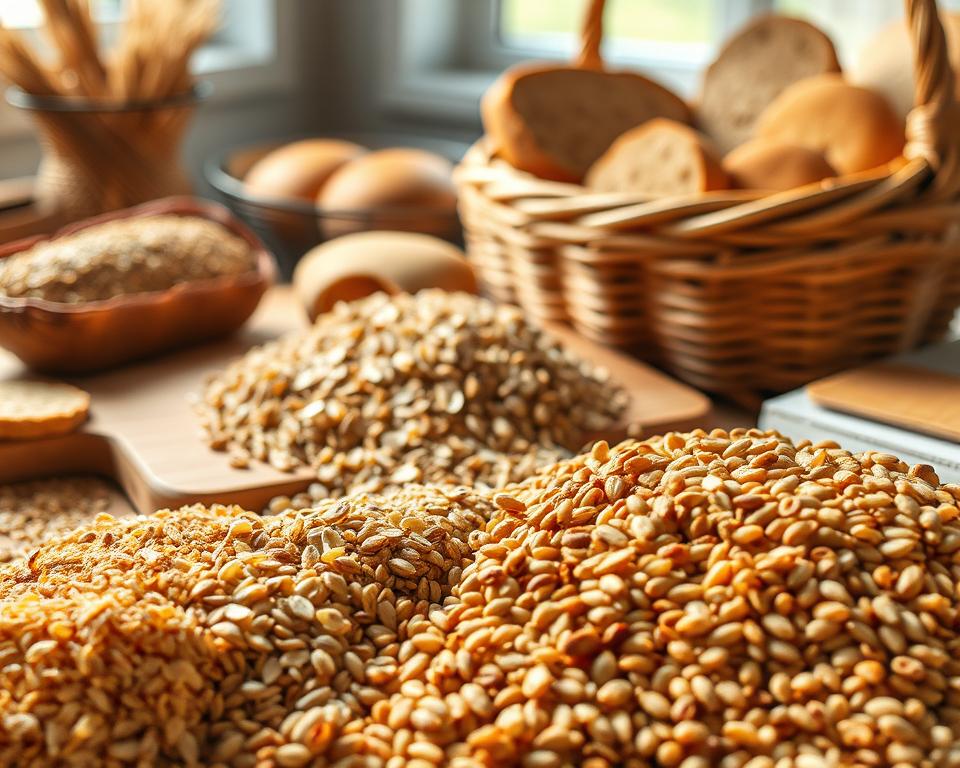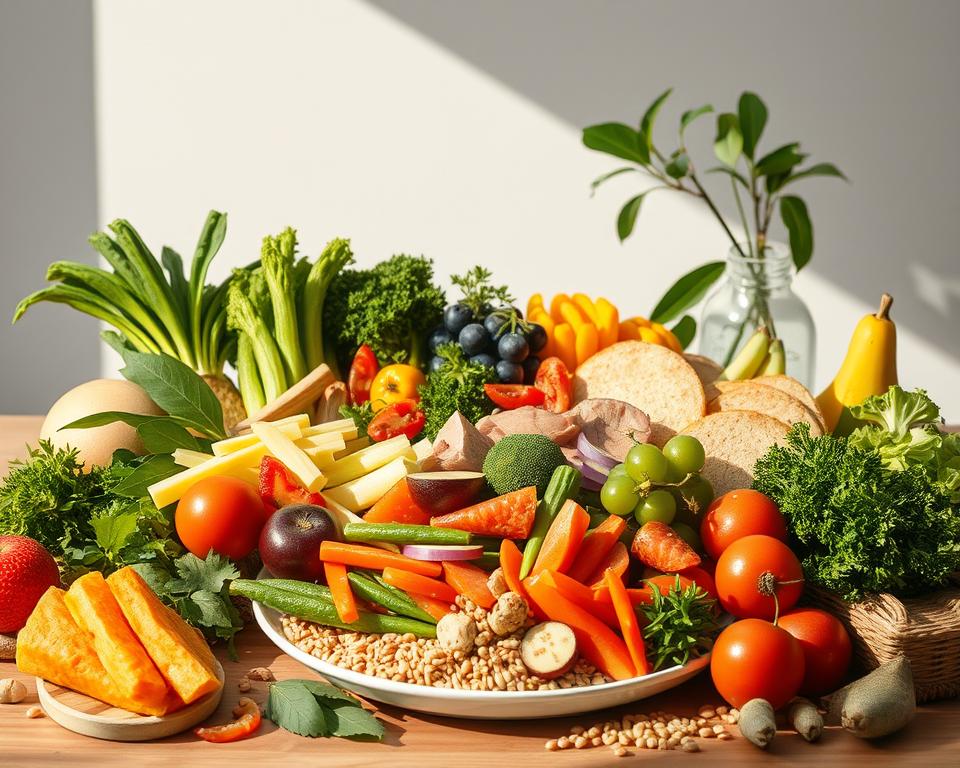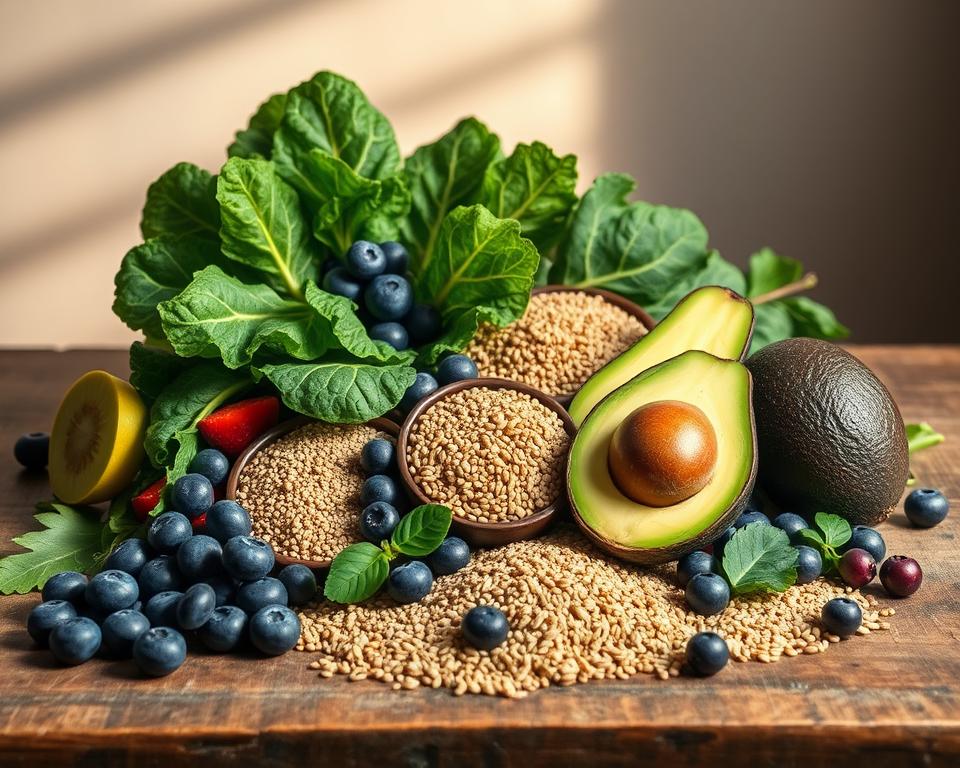Anúncios
Could a simple plate change make your meals tastier and healthier?
This nutrition guide 2025 brings key recommendations from Harvard’s Healthy Eating Plate, the latest scientific report, and WHO into one friendly resource.
You’ll find practical tips for making half your plate vegetables and fruits, a quarter whole grains, and a quarter healthy proteins. The guide highlights plant-forward proteins like beans, lentils, nuts, soy, and seafood, and explains portion size and everyday swaps.
Public health goals—less added sugar, lower sodium, and minimal trans fats—frame the advice so you can enjoy food that fits your culture and budget.
What you’ll get: simple examples, shopping ideas, and planning tools to try at home, plus notes on equity and access so more people can benefit.
Anúncios
This is cultural and practical, not medical advice; for personal concerns, contact a registered dietitian or qualified professional.
Introduction to the nutrition guide 2025
Your diet can change how you feel each day, and the latest scientific report translates research into simple choices you can use at home, work, and on the go.
The report underscores gaps many people face: too much added sugar, sodium, and saturated fat, and too little vegetables, fruit, and whole grains. It also recommends more plant-based proteins, “mostly whole grains,” clearer portion guidance, and fewer red and processed meats—changes grounded in current evidence.
Anúncios
Why this matters now: these shifts reflect persistent patterns that affect public health. The report and sources like Harvard’s Healthy Eating Plate and WHO offer consistent targets and practical signals, such as making water your default beverage and aiming for specific limits on sugars, saturated fat, and salt.
How to use this resource: start with the plate method, then read sections on beverages, fats and proteins, grains and portion sizes, and sustainability tools. You’ll find quick swaps, market examples, and meal prompts that respect culture and time.
Set expectations: these are informative, not medical prescriptions. Try one small change this week—maybe a swap in beverages or a portion tweak—and consult a registered dietitian for tailored advice.
Build your plate for everyday meals
Build simple plates you enjoy so everyday meals feel doable and delicious. Use the plate as an easy template: half vegetables and fruit, a quarter whole grains, and a quarter healthy proteins. Keep flavors and culture front and center so swaps fit your taste.
Half your plate vegetables and fruits
Fill half the plate with colorful vegetables and fruit — spinach, tomatoes, citrus, or berries work well. Remember, fries and chips don’t count as vegetables.
Quarter plate whole grains for steady energy
Add a quarter plate of whole grains like brown rice, oats, or quinoa to help steady energy across the day. Whole grains pair well with bowls, salads, and tacos.
Quarter plate healthy proteins with a plant-forward focus
Choose beans, lentils, tofu, fish, or poultry for the protein quarter. Rotate options to keep meals interesting and use canned or frozen items to save money.
Use healthy oils and keep moving
Cook with olive or canola oil and avoid deep-frying to control added calories. Make water your default drink at the table, and try a short walk after meals to support routine.
- Simple swap: canned beans (rinsed) for processed meats.
- Flavor tip: herbs, lemon, and spices add taste without heavy sauces.
- Budget idea: frozen vegetables and seasonal fruit are smart foods that stretch dollars.
What’s new from the 2025 Scientific Report
The latest scientific report shifts the spotlight toward plant-forward protein choices and clearer grain guidance.
The report reorders protein groups so beans, peas, and lentils come first, followed by nuts, seeds, and soy. Seafood, then meats and poultry, appear later. This change nudges you toward plant-based proteins without banning animal foods.
Practical protein and grain updates
What to do: try a few meat-free meals each week and use canned beans or tofu as easy swaps. The phrase “mostly whole grains” replaces older wording to help you pick intact grains like oats, brown rice, and quinoa.
Portions, fats, and beverages
The report gives concrete portion help: pre-portioned packs and smaller plates can reduce intake of energy-dense items. It also keeps the saturated fat target under 10% of calories and urges swaps to unsaturated oils. Plain water remains the primary beverage choice; caffeine limits for most adults stay the same.
Limits and the equity lens
There are no new recommendations on ultra-processed foods yet; the evidence is still mixed. Alcohol is under separate review, so guidance is pending. The committee explicitly considered access and culture, aiming for patterns that work in diverse communities.
- Quick takeaway: lean on canned beans, frozen veg, and whole grains.
- Small change: swap one red-meat meal per week for a plant-forward option.
- Keep perspective: these are population-level recommendations, not medical prescriptions.
Beverages, sugars, and sodium made simple
Small swaps in what you sip can cut a lot of added sugar and sodium from your day. Start with clear actions you can use right away.
Make water your default
Make plain Nước your go-to. Try sparkling or still with a slice of lemon, cucumber, or mint for flavor without extra calories.
Keep a reusable bottle at work and in your bag so water is the easy choice all day.
Milk, fortified soy drinks, tea, and coffee in moderation
If you drink dairy, aim for 1–2 servings per day and pick unsweetened low-fat options. Fortified soy beverages are a plant-friendly swap without added sugar.
Keep coffee and tea simple—limit syrups and creams and stay near 400 mg caffeine per day for most healthy adults.
Limit free sugars and avoid sugary drinks
Sweetened sodas and energy drinks are top sources of added sugars. Swap seltzer with a splash of 100% juice or unsweetened iced tea to lower calories and sugar.
Keep sodium in check with smart swaps
Watch labels: sauces, breads, and canned soups drive up sodium. Choose “low sodium” or “no salt added” products and rinse canned goods to cut the sodium amount.
- Label tip: check sodium and sugar per serving, not per package.
- Shop smart: buy low-sodium sauces and unsweetened beverages.
- Flavor idea: use herbs, citrus, and vinegar instead of salt.
Fats and proteins: quality over quantity
Choose richer plant oils and a wider mix of proteins to keep meals flavorful and flexible.
Swap smartly: the WHO and major dietary committees recommend keeping saturated fat under about 10% of calories and avoiding industrial trans fat. Replace those with unsaturated fats from olive, canola, and other plant oils when you cook.
Build protein variety across the week. Center meals on beans, lentils, soy, nuts, and seeds, and include fish or poultry a few times weekly.
Keep red meat portions smaller and limit processed meats like bacon and sausage in everyday cooking. For adults planning meals, steam, bake, grill, or sauté with a small amount of oil instead of deep-frying.
- Budget swaps: canned beans or lentils in chili, canned tuna or salmon for quick meals, and tofu stir-fries with frozen vegetables.
- Flavor tips: use herbs, citrus, garlic, and spices instead of heavy sauces.
- Dairy choices: pick lower-saturated-fat options and watch flavored products for added sugars.
Read ingredient lists to avoid partially hydrogenated oils and ultra-salty cured meats. Focus on quality of fats and diverse proteins to support tasty, practical patterns without strict rules.
Whole grains and portion guidance for real life
Choose mostly whole grains and simple portion tricks so meals feel easier and more satisfying.

Choose mostly whole grains and watch refined options
Pick whole grains: look for “100% whole wheat,” oats, brown rice, quinoa, barley, or whole-grain corn tortillas. Compare labels by checking that a whole grain is the first ingredient and that fiber appears on the nutrition panel.
Right-size portions at home and on the go
Use simple sizes to measure portions: a cupped hand for cooked grains, a fist for a serving of rice, or a small scoop. Pre-portion snacks and batch-cook bowls for busy days.
“Pre-portioning saves time and helps you control calories without counting every bite.”
- Dining out: share sides, ask for half portions, or box part of your plate up front.
- On-the-go: pack brown rice bowls with beans and veggies or whole-wheat pasta salads for quick meals.
- Mẹo thực tế: keep a measuring cup in your grain container so daily amounts stay consistent.
Adjust portions to your activity and hunger. Focus on steady consumption across the day rather than perfection at one meal. Choose whole-grain foods that fit your culture—wild rice, couscous, or corn masa—and keep portion sizes reasonable.
Food culture, sustainability, and foodtech in 2025
Food traditions and sustainability can fit together when you choose lower-impact ingredients that you enjoy.
Lower-impact choices that fit your taste: Pick plant-forward meals built around beans, lentils, soy, vegetables, fruit, nuts, and whole grains. These foods often have smaller footprints than meat-centric plates and still deliver big flavor.
When you want seafood, opt for fish listed in sustainability guides—sardines or salmon work well in grain bowls and salads. Frozen produce, canned fish, and dry beans are budget-friendly and shelf-stable options.
Labels, apps, and planning tools that help you eat well
Read front-of-pack cues and ingredient lists to spot added sodium and sugars in products. WHO and other agencies support clearer labeling and reformulation to make healthier products easier to find.
Use apps for pantry tracking, shopping lists, and meal planning to cut waste and save time. Try a weekly plan with two grains, three vegetables, and two proteins to mix meals quickly.
“Small, consistent changes add up—supporting public health and lowering risk for diet-related disease while keeping food you love.”
- Plan: mix and match staples to keep meals varied and affordable.
- Choose: reformulated products lower in sodium and added sugars when possible.
- Respect: adapt family recipes rather than replace them to preserve culture.
Phần kết luận
,Use these practical ideas to shape meals that fit your taste, budget, and routine.
Focus on the plate: half vegetables and fruit, a quarter whole grains, and a quarter plant-forward proteins like beans, soy, or fish. The 2025 report and WHO targets point to clearer limits for added sugars, saturated fat, trans fat, and sodium.
Make water your main beverage, shift fats toward unsaturated oils, and choose fewer red and processed meats. Pay attention to portions and repeat small swaps so benefits build over time.
For personal needs—athletes, older adults, or medical conditions—consult a registered dietitian or other health professional. Enjoy exploring food culture while supporting your body and long-term health.



